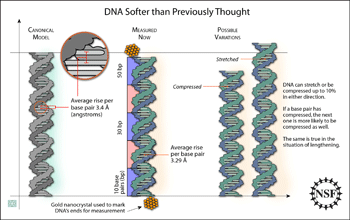Multimedia Gallery
DNA Softer Than Previously Thought
The double helix of DNA has been thought to behave as a stiff elastic rod. However, current research has shown it is much softer than previously thought. The rungs of the DNA's ladder, or base pairs, can compress or elongate, coming up to 10 percent closer or farther apart than the average. Most surprisingly, scientists found that if a base pair has compressed, the base pairs for at least the next two turns of the double helix are more likely to be compressed as well. Because this study--by a team of Stanford University scientists, supported in part by the National Science Foundation--has shown that regions of DNA affect neighboring regions, this might mean that proteins binding to DNA communicate at greater molecular distances than previously thought.
This image accompanied NSF press release, "More Spring in the Double Helix's Step."
Credit: Zina Deretsky, National Science Foundation
Images and other media in the National Science Foundation Multimedia Gallery are available for use in print and electronic material by NSF employees, members of the media, university staff, teachers and the general public. All media in the gallery are intended for personal, educational and nonprofit/non-commercial use only.
Images credited to the National Science Foundation, a federal agency, are in the public domain. The images were created by employees of the United States Government as part of their official duties or prepared by contractors as "works for hire" for NSF. You may freely use NSF-credited images and, at your discretion, credit NSF with a "Courtesy: National Science Foundation" notation.
Additional information about general usage can be found in Conditions.
Also Available:
Download the high-resolution JPG version of the image. (576 KB)
Use your mouse to right-click (Mac users may need to Ctrl-click) the link above and choose the option that will save the file or target to your computer.

